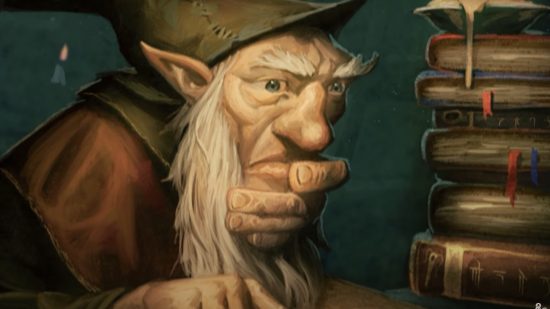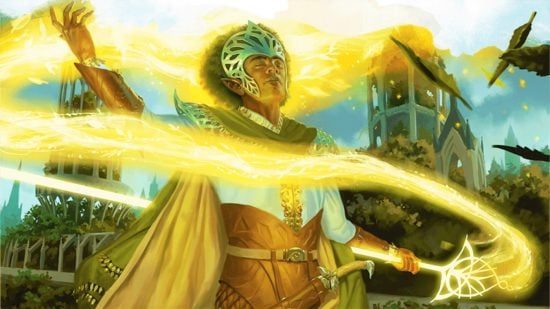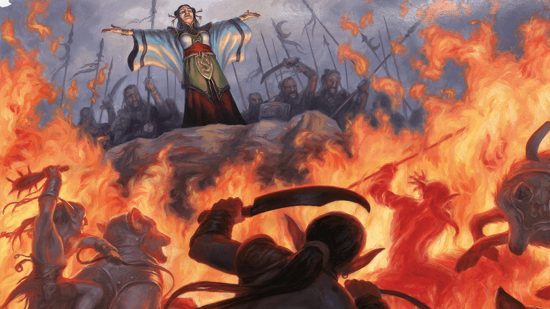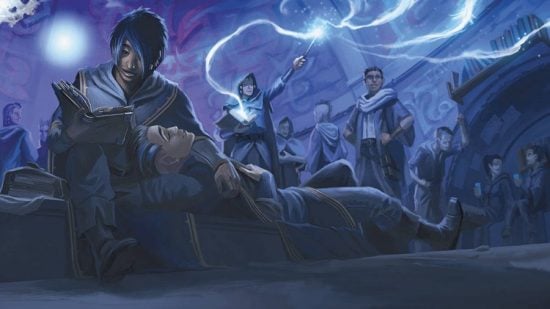With a whopping 14 DnD Cleric subclasses to choose from, fans of this particular class are spoiled for choice. The sheer variety of the Cleric subclasses 5e offers means that a Cleric can do pretty much anything if they set their mind to it. But with so many options, you may be praying to the Dungeons and Dragons gods for a sign – which Cleric Domain should you choose?
Below you’ll find a ranked list of each Domain. If you’re looking for a thorough explainer for these subclasses, our dedicated DnD Cleric guide is the place to go. Our DnD classes guide can also give you an overview of all character class options, and we’ve even compiled the DnD Cleric spells list to help with your DnD character build even further.
From worst to best, here are the DnD Cleric subclasses 5e, ranked:
- 14. Nature Domain 5e
- 13. War Domain 5e
- 12. Death Domain 5e
- 11. Knowledge Domain 5e
- 10. Trickery Domain 5e
- 9. Arcana Domain 5e
- 8. Life Domain 5e
- 7. Tempest Domain 5e
- 6. Grave Domain 5e
- 5. Peace Domain 5e
- 4. Forge Domain 5e
- 3. Light Domain 5e
- 2. Order Domain 5e
- 1. Twilight Domain 5e
14. Nature Domain 5e
Found in: Player’s Handbook
The Nature Domain 5e subclass adds a touch of DnD Druid to your Cleric. You’ll gain a few extra Druid cantrips, and both your spell list and Channel Divinity revolve around commanding flora and fauna. It’s this theme that really lets the Nature Cleric down, though – these early-level features are far too situational, and they can feel underwhelming to play.
The Nature Cleric does have some impressive abilities at levels six and eight. You’ll be able to deal extra damage and grant resistance to certain elements – and you can switch up what these elements are, which gives you a lot of combat versatility.
Sadly, you’ll go right back to the animal charmer schtick at level 17, with an ability that lets you command a creature you’ve charmed as a bonus action. It’s handy in the right scenarios, but those are never guaranteed.
13. War Domain 5e
Found in: Player’s Handbook
As the name implies, the War Domain 5e subclass is all about combat. You’re handed some heavy DnD armor, a mix of offensive and defensive spells, and the ability to add a +10 bonus to your (or someone else’s) attack roll with Channel Divinity. Oh, and you can perform an extra attack with your bonus action sometimes.
All of this sounds great in principle, but there are a few caveats that turn this into one of the weaker Cleric Domains. Your attack bonuses are limited to your Channel Divinity charges, and you can only use that bonus action attack once per long rest 5e. If you want a subclass that could keep up with the DnD Paladins and 5e Fighters in your party, the War Domain will fall short fairly quickly.
12. Death Domain 5e
Found in: Dungeon Master’s Guide
The Death Domain 5e is for Clerics who want to focus solely on damage output (read: killing things). You’re going to learn a lot of necromancy 5e spells, and most of your subclass abilities focus on increasing your damage and the number of creatures you can target.
Few creatures are prepared to resist the necrotic damage you’ll be doling out, but Death Clerics fall behind other combat-focused Clerics. This is partly down to a mediocre spell list (necromancy is a pretty lukewarm DnD school of magic). Overall, the Death Domain is a fairly simple class with lots of flavor but middling power levels.
11. Knowledge Domain 5e
Found in: Player’s Handbook
The Knowledge Domain 5e turns your Cleric into the Skill Monkey of the party. You can add double your proficiency bonus to two Intelligence-based DnD skills of your choice, and Channel Divinity can be used to gain a new proficiency for ten minutes – or read someone’s thoughts and sneakily cast Suggestion on them.
All these features are pretty useful, but any DnD Bard or Rogue 5e classes in the party will definitely outshine you. Plus, the Domain’s 17th level feature is incredibly situational, and it relies heavily on the lenience of your Dungeon Master.
You can learn the origin of an object or see recent events in an area by meditating, but these abilities may pull up useless information if the DM isn’t prepared. Meanwhile, all the other Clerics are excelling at healing and combat – the Knowledge Domain feels lackluster in comparison.
10. Trickery Domain 5e
Found in: Player’s Handbook
The Trickery Domain 5e is all about illusions, enchantments, and utility. It provides an excellent spell list that’ll help you sneak and schmooze your way out of tricky situations. Plus, you can give the clumsier members of your party advantage on Stealth checks – a life-saver in those moments where subtlety is essential.
The Trickery Cleric’s Channel Divinity ability can be powerful, but it can be challenging to optimize. Invoke Duplicity gives you an illusory double that, as long as you keep up your concentration and position it right, lets you cast spells from its location and grants advantage on your attacks. You’ll need to perfectly position yourself on the battlefield to truly reap its rewards.
At later levels, you get a single round of invisibility in combat, as well as extra poison damage for your attacks and the ability to create four duplicates of yourself. The usefulness of these features is a bit of a mixed bag, and that’s the feel of this Domain overall – it has some truly high highs but may occasionally fall flat.
9. Arcana Domain 5e
Found in: Sword Coast Adventurer’s Guide
Many of the Cleric Domains take inspiration from other classes, and the Arcana Domain 5e has been taking notes from the DnD Wizard. This gets you a few extra Wizard cantrips, as well as a spell list with a great balance of utility, support, and offense. Later, you’ll be able to end spells affecting allies you’ve healed, boost your cantrip damage, and learn even more DnD Wizard spells.
Your Channel Divinity can now turn celestials, elementals, fey, and fiends – which makes it a little situational, but slightly more broad than the version that focuses on undead only. However, if you want a Cleric that goes all in on magic, the Arcana Domain is a pretty good option.
8. Life Domain 5e
Found in: Player’s Handbook
If you want to heal your friends, the Life Domain 5e Cleric does it better than anybody else. That’s basically all it does, but damn this subclass has really cornered the healing market. Almost every Cleric spell you learn and every subclass ability you gain focuses on protecting or restoring sweet, sweet hit points.
At lower levels, your healing spells are naturally more effective, granting bonus HP relative to your spell’s level. Channel Divinity gives you a huge pool of HP to distribute among nearby friends, and you’ll later heal yourself any time you heal someone else. Sure, Divine Strike lets you deal some extra radiant damage, but don’t forget to heal – your 17th-level ability lets you use the highest possible dice result any time you roll to heal.
This Cleric subclass can be immensely helpful in a tough battle. Its biggest drawback is that it’s a one-trick pony, and all that healing could start to feel repetitive for a player. Still, you’ll be everyone’s best friend if you take the plunge and build a Life Cleric.
You can learn more about this subclass in our dedicated DnD Life Cleric guide.
7. Tempest Domain 5e
Found in: Player’s Handbook
If we were ranking Cleric Domains on fun factor alone, the Tempest Domain 5e would be near the top of the list. A strong spell list and varied subclass features give you the power of turbulent storms, which means you’ll be dishing out thunder and lightning damage left and right, as well as harnessing explosive area of effect spells and slashing it up in melee.
Most of your features focus on destruction, with Channel Divinity guaranteeing max damage on thunder and lightning damage, and Wrath of the Storm adding an extra 2d8 to your attacks. However, other features lean into area control to add some more strategizing to your play style. You’ll even learn to fly at the top levels – this isn’t the most overpowered Cleric out there, but it’s super engaging to play.
6. Grave Domain 5e
Found in: Xanathar’s Guide to Everything
The Grave Domain 5e subclass is all about the balance between life and death, so it makes sense that your character will dabble in a bit of healing as well as damage-dealing. You’re a highly effective healer when someone hits zero HP thanks to Circle of Mortality, and you can sense the presence of undead with Eyes of the Grave.
Your Channel Divinity allows you to change the vulnerabilities of enemies, and you can nullify those uber-dangerous critical hits. Later, you’ll be healing your allies any time an enemy dies. Combine these with a solid spell list, and you’ve got a versatile Cleric with intriguing flavor and useful abilities.
Alright, you’re not the most potent Cleric. And there are Clerics who are better at both healing and attacking, so you’re not the first choice of power builders. But for some players, balance can be just as fun as putting all your eggs in one basket.
For more details on this subclass, check out our DnD Grave Cleric guide.
5. Peace Domain 5e
Found in: Tasha’s Cauldron of Everything
The Peace Domain 5e Cleric is one of the best subclass options for players who prefer a supporting role. This doesn’t mean you lack power, though – Peace Clerics have some fantastic buffs to share with the group, and they can often do so without spending spell slots.
Emboldening Bond lets you give allies at close range a d4 attack roll bonus as long as they stay within range of each other. The Balm of Peace Channel Divinity variant is a fantastic way to get across the battlefield without triggering opportunity attacks and you can heal any creature you stop next to. Later, you can help allies teleport to avoid damage, and you can apply all these benefits at an even greater range – there’s plenty of power for a clever player to unlock here.
4. Forge Domain 5e
Found in: Xanathar’s Guide to Everything
The Forge Domain 5e turns your Cleric into a chunky combatant who’s useful to know, both on and off the battlefield. A strong spell list and useful subclass features give you some interesting utility and turn you into one of the best defenders in the Cleric family.
There’s something of a DnD Artificer in this class, as you’re able to craft non-magical items with your Channel Divinity. You can also buff armor and DnD weapons with a bit of your magic. Thanks to heavy armor proficiency and your subclass features, your armor class and damage resistance only gets better as you level up. Fire is a major thing for you – you deal extra damage of this type and will be immune to it eventually.
This is a subclass that’s flavorful, fun to play, and filled with powerful potential. You’re not the best damage dealer out there, but you’re very hard to knock down. Plus, this is a class that can be highly rewarding for roleplayers who think outside the box.
If this sounds like your kind of Cleric, here’s a full DnD Forge Cleric subclass guide.
3. Light Domain 5e
Found in: Player’s Handbook
When people think of offensive Cleric builds, the Light Domain 5e subclass is one of the first that will come to mind. Eviscerate large swathes of foes with a well-timed Fireball 5e, or blind enemies so you and your pals can dodge damage. This is a Cleric that excels in battle, regardless of how many enemies they’re up against.
Your Channel Divinity dishes out radiant damage to all hostels within a certain range, and you can light up the battlefield like a Christmas tree, with more and more opportunities to disadvantage foes as you level up. You’re not the traditional supportive healer type, but with so many ways to influence a fight, hopefully you won’t need to be.
2. Order Domain 5e
Found in: Tasha’s Cauldron of Everything / Guildmaster’s Guide to Ravnica
Unsurprisingly, the Order Domain 5e subclass is all about control. Your spell list forces enemies to comply with your will, and you’re proficient in both Persuasion and Intimidation. You even have control over your own friends, with the power to grant them extra attacks as early as level one.
The Order Domain is mainly about combat prowess, but its spell list does offer a few support and roleplaying options. Channel Divinity charms and disarms your foes, and you can cast enchantment spells as a bonus action from sixth level.
Your later features all focus on dealing extra psychic damage – which is rather unimpressive considering your level. However, few DnD campaigns spend time at higher levels, so this is only a concern in those exceptional games that continue past level ten. In most games, you’ll feel like a powerhouse.
1. Twilight Domain 5e
Found in: Tasha’s Cauldron of Everything
The Twilight Domain 5e has a finger in almost every pie, and it’s excellent at pretty much everything it sets out to do. Starting with a stellar spell list that mixes utility and support, plus a vital heavy armor proficiency, you’re already great at many of the things a Cleric does best.
You can share the power of Darkvision with any unlucky DnD Humans in your party, and you can give a friend advantage on initiative rolls – which is an incredible level one feature for a party with a plan. Your Channel Divinity creates a moving sphere that can heal or end those pesky charmed or frightened conditions, and you’ll eventually be able to fly as a bonus action. Rounding off the subclass is a dose of bonus radiant damage and the ability to give your allies half cover wherever you are.
This is one of the most consistent Cleric subclasses out there. Its versatility and overall strength make it the top Domain we’d recommend, whatever your experience level.
You can learn even more about the DnD Twilight Cleric in our dedicated guide.
For more character recommendations, here’s everything you need to know about DnD races. We’ve also ranked plenty more subclasses, including the DnD Paladin subclasses, DnD Monk subclasses, and DnD Ranger subclasses.














